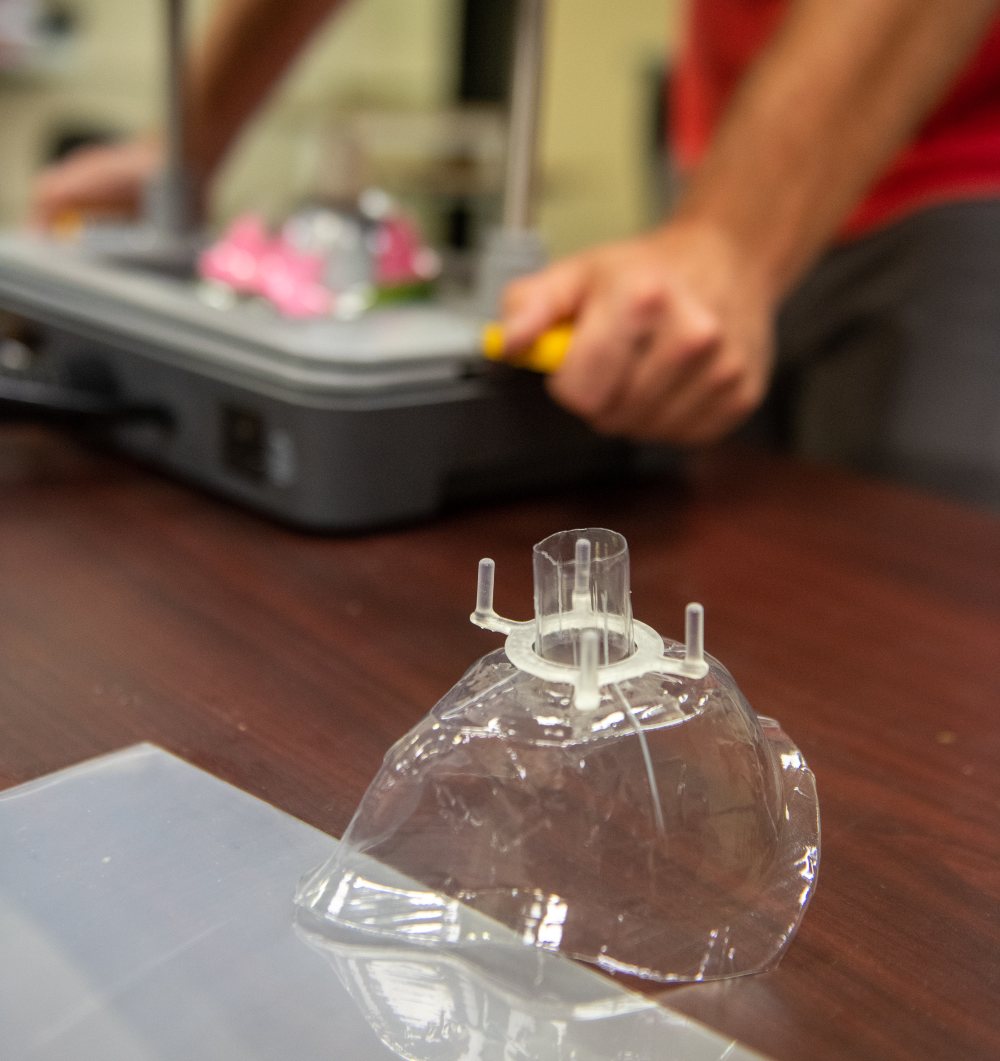USM Team Creates Respirator Mask to Aid Nationwide Deficit
Tue, 04/07/2020 - 01:21pm | By: Margaret Ann Macloud
 Medical professionals in the Pine Belt who are treating patients with COVID-19 gained
access to 250 respirator masks and counting over the weekend, thanks to a University
of Southern Mississippi (USM) mathematics professor.
Medical professionals in the Pine Belt who are treating patients with COVID-19 gained
access to 250 respirator masks and counting over the weekend, thanks to a University
of Southern Mississippi (USM) mathematics professor.
Dr. Anna Wan, director of USM’s 3-D printing lab, called the Eagle Maker Hub, has friends in Los Angeles and New York City—hotbeds for the novel coronavirus— who asked her to come up with an idea to aid the mask deficit. Between her expertise as a digital fabrication specialist and access to a dozen high-end 3-D printers, Wan had the tools she needed to create a solution.
“I posted on Facebook last Saturday that I was printing this mask prototype to test, and I’ll see how it does in the morning, and the next morning, Hattiesburg Mayor Toby Barker messaged me asking if I could create these for our local healthcare workers,” Wan said.
Less than two weeks and three prototypes later, through a partnership with the Mississippi Polymer Institute and USM’s School of Mathematics and Natural Sciences, and cooperation of other USM faculty, staff, and students, Wan’s Eagle Maker team delivered the first set of masks to Forrest General Hospital.
The rapid product development cycle included several iterations that are still being optimized. The mask molds were created using 3-D printing, plaster, and silicone. For speed, Wan and her team utilized a thermal molding process known as thermoforming. Plastic sheets are formed over the molds to create the masks. Once the hospital verified with positive fit and leak test results, the masks were replicated. Because of the shortage of raw materials, different materials and thermoformers were evaluated for use. The mask as-made does not include a filter but has a “hub” that acts as the standardized connection port.
The team coined the name “The Hub Mask.” Not only does this mask serve as a hub to multiple filters of the same tube size, the name is also a nod to the Hub City, where all members of the team came together and worked tirelessly to make this solution a reality for medical professionals. When in use by the hospital, the masks are hooked up to an existing hospital n99 filter, which is a uniform system in hospitals nationwide, meaning others could also use Wan’s model.
“I feel like this could potentially disrupt the industry,” Wan said. “The fabric masks healthcare workers are currently using still serve a purpose, but what we’ve come up with is phenomenal in terms of the suction to the face.”
That suction is key in the mask doing its job and passing two required tests before being used in a medical setting: a fit test and a breathability test. Wan worked closely with Hattiesburg Clinic physician and Forrest General’s Chief Anesthesiologist Dr. Joe Campbell and Director of Respiratory Therapy Dr. Brittany Coberly; Hattiesburg Clinic pulmonologist and Forrest General’s Director of ICU, Dr. Steven Stogner; as well as Hattiesburg Clinic nephrologist, Dr. John Fitzpatrick.
“We fit tested the masks and worked our hardest to find an option to best suit our needs if we got to the point of no other option,” said Dr. Coberly. “I have staff that have volunteered to test these and have worn them around to try and find flaws and they truly love them. It is my hope that these masks can go down the route of getting further approval on these and hoping one day a mask like this can be what we use as a n95, they are that comfortable. It’s not often that different healthcare providers and researchers get to come together to make something like this happen, but this speaks to how successful that can be when you get key players together.”
Wan and team are currently using standard, food-grade materials in a solid form, and because no new filtration media is being employed, it is easily adopted into the market where the approved filters can then be added for use. Dr. Monica Tisack Kathmann, director of the Mississippi Polymer Institute (MPI) at USM, explained that the Centers for Disease Control and Prevention has recognized the dire need for masks and taken immediate actions to approve the use of products that increase the chance of protection.
“In simple terms, when you get into a high-risk situation that is urgent with no other options available, anything is better than nothing,” Kathmann said. “Because of the shortage of supply, the MPI team is aggressively seeking, sourcing, and developing all options that can be used to make these masks, and if it were not for Dr. Wan’s spearheading efforts, we wouldn’t be this far.”
Community members and quilting clubs organized to create straps for the masks from cotton fabric and t-shirts. Each mask only costs approximately $2 to make in materials. Drs. Wan and Kathmann are currently seeking funding in order to quickly scale up and produce more masks.
“In so many ways, scientists at USM stepped up and forward when the healthcare community had a need,” said Dr. Stogner. “For example, we need special face masks for personal protection –and what did they do? They went to their labs—and what did we get—just what we needed!”